Tragedy in Central Texas
God sent devastating floods to Central Texas. Humans compounded the damage in almost every possible way. Is God the only one we will hold accountable?
Welcome to another installment of Life Its Ownself. If you like what you read, please 1) hit the Like button at the bottom of this installment, 2) subscribe to this newsletter, and 3) tell your 1,000 best friends to read and subscribe. Also, feel free to comment below. I’d love to hear your thoughts.
Tuesday, July 15, 2025
I.
For many people in Texas, future July 4th weekends will no long be remembered for hot dogs and pool parties and fireworks arcing up into a cloudless Texas twilight. Instead, it will call to mind the terrifying midnight scramble to evacuate a camp dormitory, a vacation home, or an RV in pitch blackness; horrifying reports of torrential rains and raging floodwaters; of loved ones missing; of trees and cars and lifeless bodies pried from river channels re-shaped by nature’s greatest forces.
Hopefully, the painful memories of tragedy will be eased by the knowledge that steps have been taken to prevent such a disaster from occurring again. But that will require a level of truth and honesty from elected officials and clear-eyed, unsentimental accountability from citizens that is impossible to guarantee in these times.
(When 19 students and two teachers were massacred in Uvalde just three years ago, the local community closed that cursed building and increased safety at its other educational institutions. But the state and federal governments failed that grieving community completely, making it easier, not harder, for degenerate incels to get and use semiautomatic rifles to snuff out lives. And no one has held them accountable.)
Our leaders keep telling us that this is “an Act of God,” and that “nothing could be done” either to anticipate or mitigate it. But the same God who caused the floods gave us intelligence, free will and agency to stop them from killing as many people as it did. We – all of us – must quit hiding behind God’s skirts and acting like there’s nothing we could, or can, do.
So let’s begin by forgiving God for causing the floods and set about the harder business of learning what we mere mortals could have done to prevent or ease its effects.
II.
I have personal ties to the Guadalupe River. For most of the 1970s, I spent my summers as a counselor at Camp Tecaboca near Mountain Home. I had many occasions to visit “Camp Row,” the stretch of Highway 39 along which some of the oldest summer camps in Texas are located. The highway follows the South Fork of the Guadalupe River, which emerges from the springs and limestone canyons of southwestern Kerr County. The river, slow and shallow, winds past camps with names like Mystic, Heart o’ the Hills, Rio Vista, La Junta and Flaming Arrow. At the little hamlet of Hunt, it meets up with the North Fork of the Guadalupe along which are more camps: Stewart, Waldemar, MoRanch.
The river wanders east from Hunt to Ingram, where the Johnson Fork empties into the main concourse. Tecaboca was located on the Johnson Fork.
From Ingram, the river – and it is by now a navigable river – flows to Kerrville, Center Point and, beyond, Canyon Lake before its long journey across the Texas coastal plains to the sea.
Camp Tecaboca was known as “the Catholic camp,” and on Saturday afternoons and Sunday mornings the priests in residence there traveled like circuit preachers to the other camps to say Mass for their Catholic campers. The priests had a backpack with a chalice, hosts to be consecrated, small bottles of wine and water and their vestments. Every now and then during those summers, I would ride along with the priests as they brought salvation-in-a-satchel to the other camps. I visited and spent time at Mystic, and Waldemar, and Rio Vista, and most of the other camps in the area.
III.
“Camp Row” is part of “Flash Flood Alley,” the belt of Texas where rainfall and geology can turn a peaceful river into a raging torrent that sweeps everything before it and literally re-sculpts the geography of the river channel.
The farmers, ranchers, and even camp directors along the North, South, and Johnson Creek forks of the Guadalupe knew this, of course, and had a system for warning each other: as the water rose on my property, I called my neighbor downstream and warned him, and so on down the (land)line.
That worked pretty well in the 1970s, when the whole county had less than 20,000 people. It failed catastrophically last week, when Kerr County’s population had surged to 54,000 and the summer camps had expanded their facilities to accommodate more campers.
IV.
The most disingenuous thing anyone could say about the July 4th floods is “no one could have foreseen this.” Out of respect for your intelligence, I will spare you the parade of politicians, civic leaders, ministers and other pillars of our communities who’ve said exactly that in the last ten days.
The flood iself was an extraordinary catastrophe. Its occurrence, however, was entirely predictable, if not its scope and ferocity. And the toll of death and destruction was made worse by years of human negligence and misfeasance, from local officials all the way to the federal government.
News stories have documented the failure of the Kerr County Commissioners Court, egged on by what appear to be the stupidest people on earth, to install an early warning system along the river – even when the money for such a system was offered to them.
Such systems are expensive – although probably cost-effective compared to the human, spiritual and financial costs of shattered lives for the families and loved ones of the 132 people already known dead and the 100+ others still missing.
The Guadalupe River flooding occurred at the same time as flooding in the Concho, Llano, San Gabriel and Colorado river valleys. (In fact, flooding it still occurring as of this morning.) One would hope that the state government, which has $27.1 billion in its ironically-named Rainy Day Fund, could spare a couple hundred million to install early warning technology along Texas’s most unpredictable and deadly river systems.
In fact, the Texas House passed a bill in its recently-completed session, HB 13, that would have funded communications improvements, including “a grant program to provide grants to local governments for the purchase of emergency communication equipment and infrastructure, the construction of emergency communication infrastructure, and the expenses of training employees of the local government for the effective use of the equipment during an emergency.” However, the bill died in the Senate, where Lite Guv Dan Patrick and others decided it was too costly.
Never embarrassed to be reactive instead of proactive, Governor Greg Abbott has added several items related to disaster preparedness and response to his special session agenda. It starts next week, but fair warning: legislative focus on those items will likely be drowned out (deliberate word choice) by his call for mid-decade congressional redistricting to pad the razor-thin GOP majority in the U.S. House. As always, politics takes priority.
Speaking of the federal government, it has not cloaked itself in glory in its response to the Hill Country flooding. Consider the litany of sins committed by Homeland Security Secretary and part-time ICE cosplayer Kristi Noem and her team:
the National Weather Service predicted the floods, but due to firings the liaisons between NWS and local emergency centers were not available to spread the message.
FEMA search-and-rescue contractors didn’t arrive on the scene for three days, because that’s how long it took Noem to approve the funding.
Nor, for the same reason, did FEMA’s emergency management supplies — food, water, medical kits, temporary shelters — arrive until the beginning of the next week.
When flood victims called to apply for help, there was no one to answer the phone at FEMA’s call centers because Noem laid them all off on Friday, the day after the floods.
It took a week for the director of FEMA to arrive on the scene — for what it was worth. This — I am not making this up — is the director of FEMA.
You may recall that he achieved some notoriety last month when, at a briefing for senior FEMA staff, he expressed surprise at the existence of a “hurricane season” in the U.S.
Fortunately for Texas, H-E-B had taken over FEMA’s job of providing food, water and shelter to flooding victims and first responders.
V.
It is now ten days since these terrifying and catastrophic floods laid waste to some of the most beautiful parts of the Texas Hill County. It will be years before some stretches of the rivers settle into their new normal; it will be decades, if ever, before the empty chair at a dinner table does not provoke a fresh outpouring of grief. Either because of climate change or in its complete absence (depending on your politics), storms will become more violent and the flooding they cause more deadly. Some of our leaders will step up to insist on doing things differently; others will shrug their shoulders and wait for the next disaster. And Texas will keep on being an odd mixture of the friendliest, big-hearted people and the worst state government.
And letting God take the fall for natural disasters will change none of it.




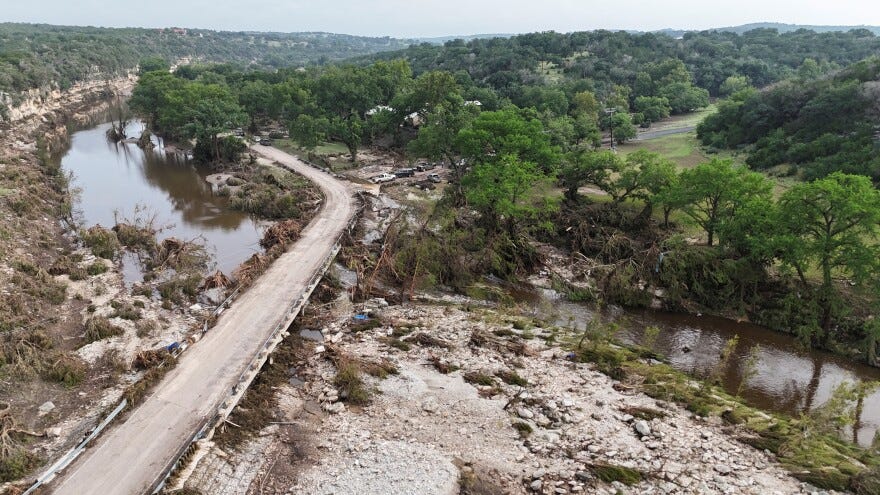

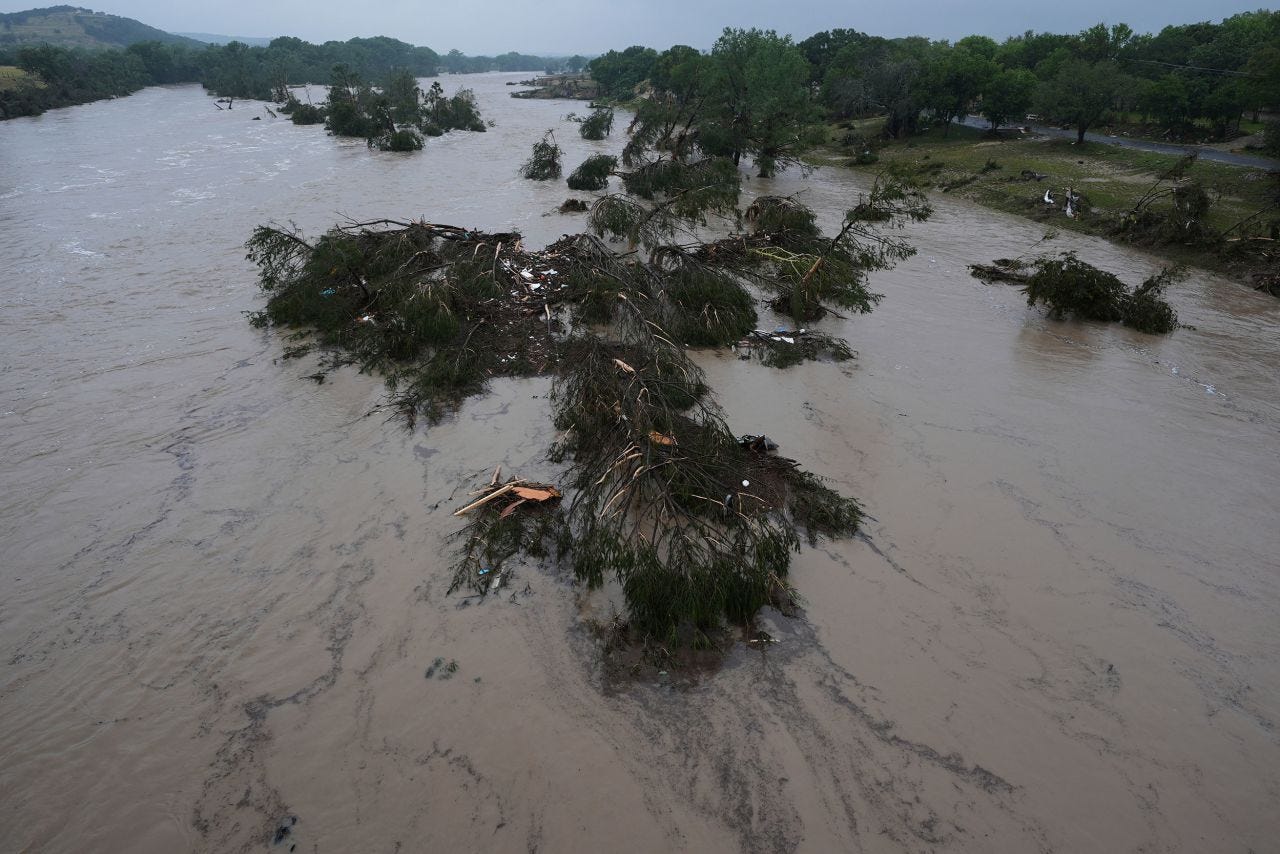
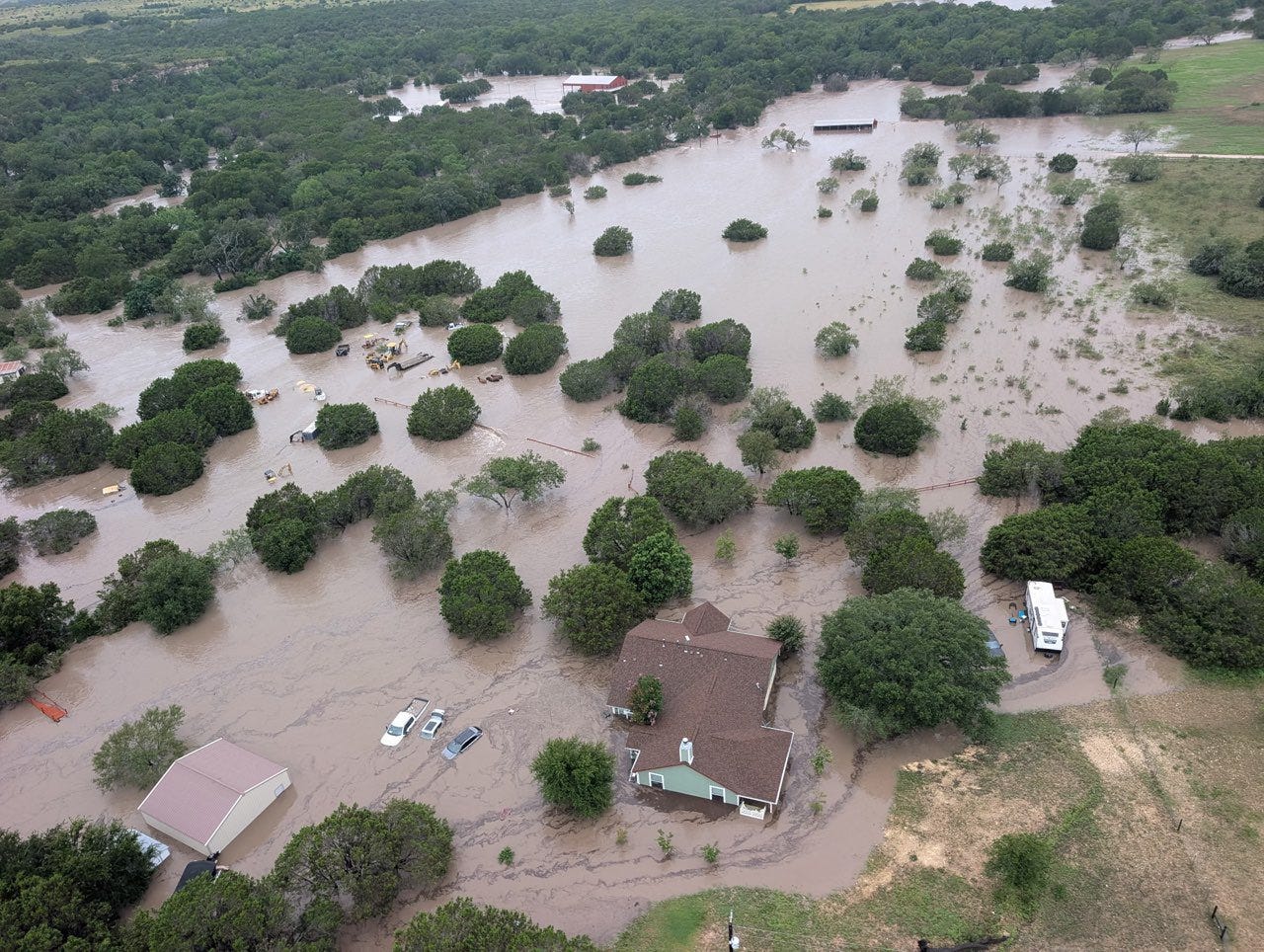
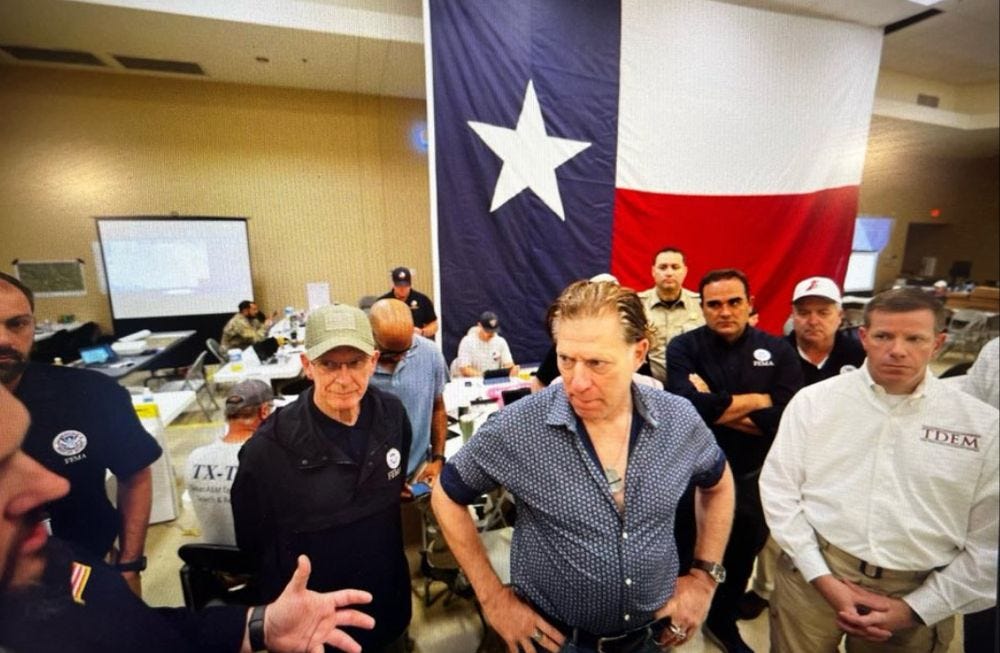
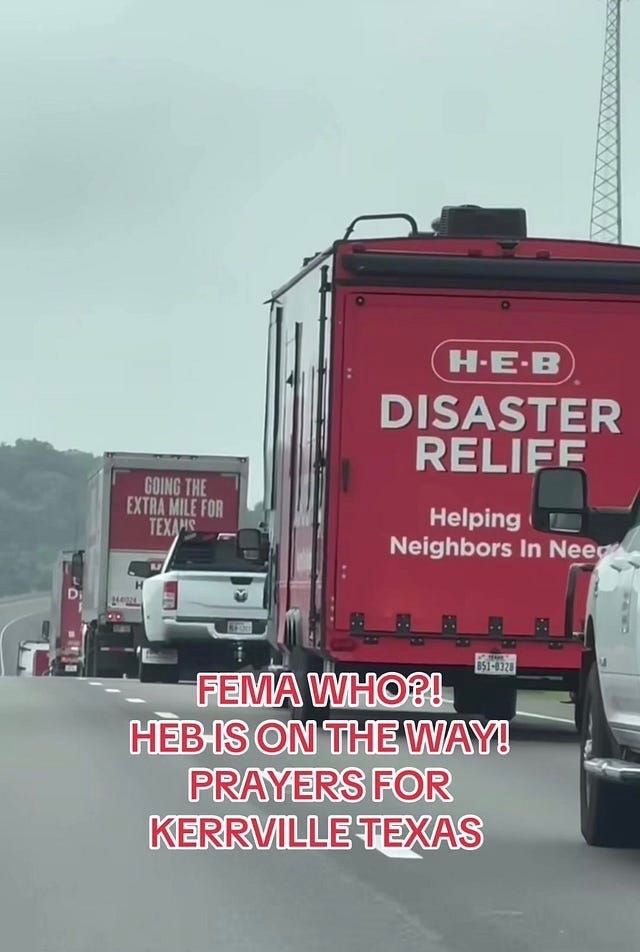
I was appalled but not surprised at the public comments urging Kerr County to refuse federal dollars for warning systems. Is there a journalist available to find those persons to ask whether they regret those statements.
Thank you Deece